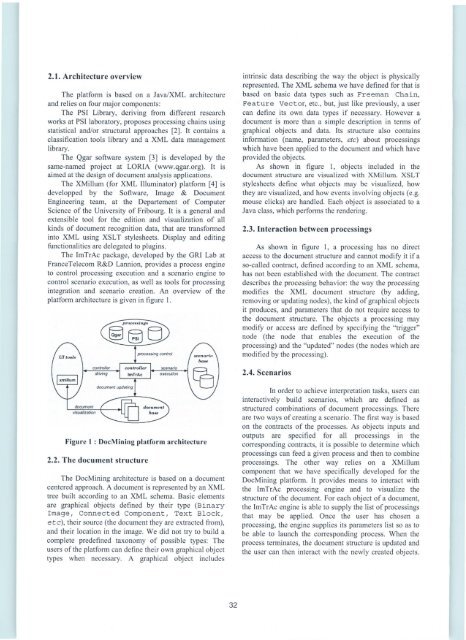RR_03_02
RR_03_02
RR_03_02
You also want an ePaper? Increase the reach of your titles
YUMPU automatically turns print PDFs into web optimized ePapers that Google loves.
2.1. Architecture overview<br />
The platform is based on a Java/XML architecture<br />
and relies on four major components:<br />
The PSI Library, deriving from different research<br />
works at PSI laboratory, proposes processing chains using<br />
statistical and/or structural approaches [2]. It contains a<br />
classification tools library and a XML data management<br />
library.<br />
The Qgar software system [3] is developed by the<br />
same-named project at LORIA (www.qgar.org).Itis<br />
aimed at the design of document analysis applications.<br />
The XMillum (for XML Illuminator) platform [4] is<br />
developped by the Software, Image & Document<br />
Engineering team, at the Departement of Computer<br />
Science of the University of Fribourg. It is a general and<br />
extensible tool for the edition and visualization of all<br />
kinds of document recognition data, that are transformed<br />
into XML using XSL T stylesheets. Display and editing<br />
functionalities are delegated to plugins.<br />
The ImTrAc package, developed by the GRI Lab at<br />
FranceTelecom R&D Lannion, provides a process engine<br />
to control processing execution and a scenario engine to<br />
control scenario execution, as well as tools for processing<br />
integration and scenario creation. An overview of the<br />
platform architecture is given in figure 1.<br />
Figure 1 : DocMining platform architecture<br />
2.2. The document structure<br />
The Doc Mining architecture is based on a document<br />
centered approach. A document is represented by an XML<br />
tree built according to an XML schema. Basic elements<br />
are graphical objects defined by their type (Binary<br />
Image, Connected Component, Text Block,<br />
etc), their source (the document they are extracted from),<br />
and their location in the image. We did not try to build a<br />
complete predefined taxonomy of possible types: The<br />
users of the platform can define their own graphical object<br />
types when necessary. A graphical object includes<br />
32<br />
intrinsic data describing the way the object is physically<br />
represented. The XML schema we have defined for that is<br />
based on basic data types such as Freeman Chain,<br />
Feature Vector, etc., but, just like previously, a user<br />
can define its own data types if necessary. However a<br />
document is more than a simple description in terms of<br />
graphical objects and data. Its structure also contains<br />
information (name, parameters, etc) about processings<br />
which have been applied to the document and which have<br />
provided the objects.<br />
As shown in figure 1, objects included in the<br />
document structure are visualized with XMillum. XSL T<br />
style sheets define what objects may be visualized, how<br />
they are visualized, and how events involving objects (e.g.<br />
mouse clicks) are handled. Each object is associated to a<br />
Java class, which performs the rendering.<br />
2.3. Interaction between processings<br />
As shown in figure 1, a processing has no direct<br />
access to the document structure and cannot modify it if a<br />
so-called contract, defined according to an XML schema,<br />
has not been established with the document. The contract<br />
describes the processing behavior: the way the processing<br />
modifies the XML document structure (by adding,<br />
removing or updating nodes), the kind of graphical objects<br />
it produces, and parameters that do not require access to<br />
the document structure. The objects a processing may<br />
modify or access are defined by specifying the "trigger"<br />
node (the node that enables the execution of the<br />
processing) and the "updated" nodes (the nodes which are<br />
modified by the processing).<br />
2.4. Scenarios<br />
In order to achieve interpretation tasks, users can<br />
interactively build scenarios, which are defined as<br />
structured combinations of document processings. There<br />
are two ways of creating a scenario. The first way is based<br />
on the contracts of the processes. As objects inputs and<br />
outputs are specified for all processings in the<br />
corresponding contracts, it is possible to determine which<br />
processings can feed a given process and then to combine<br />
processings. The other way relies on a XMillum<br />
component that we have specifically developed for the<br />
DocMining platform. It provides means to interact with<br />
the ImTrAc processing engine and to visualize the<br />
structure of the document. For each object of a document,<br />
the ImTrAc engine is able to supply the list of processings<br />
that may be applied. Once the user has chosen a<br />
processing, the engine supplies its parameters list so as to<br />
be able to launch the corresponding process. When the<br />
process terminates, the document structure is updated and<br />
the user can then interact with the newly created objects.


